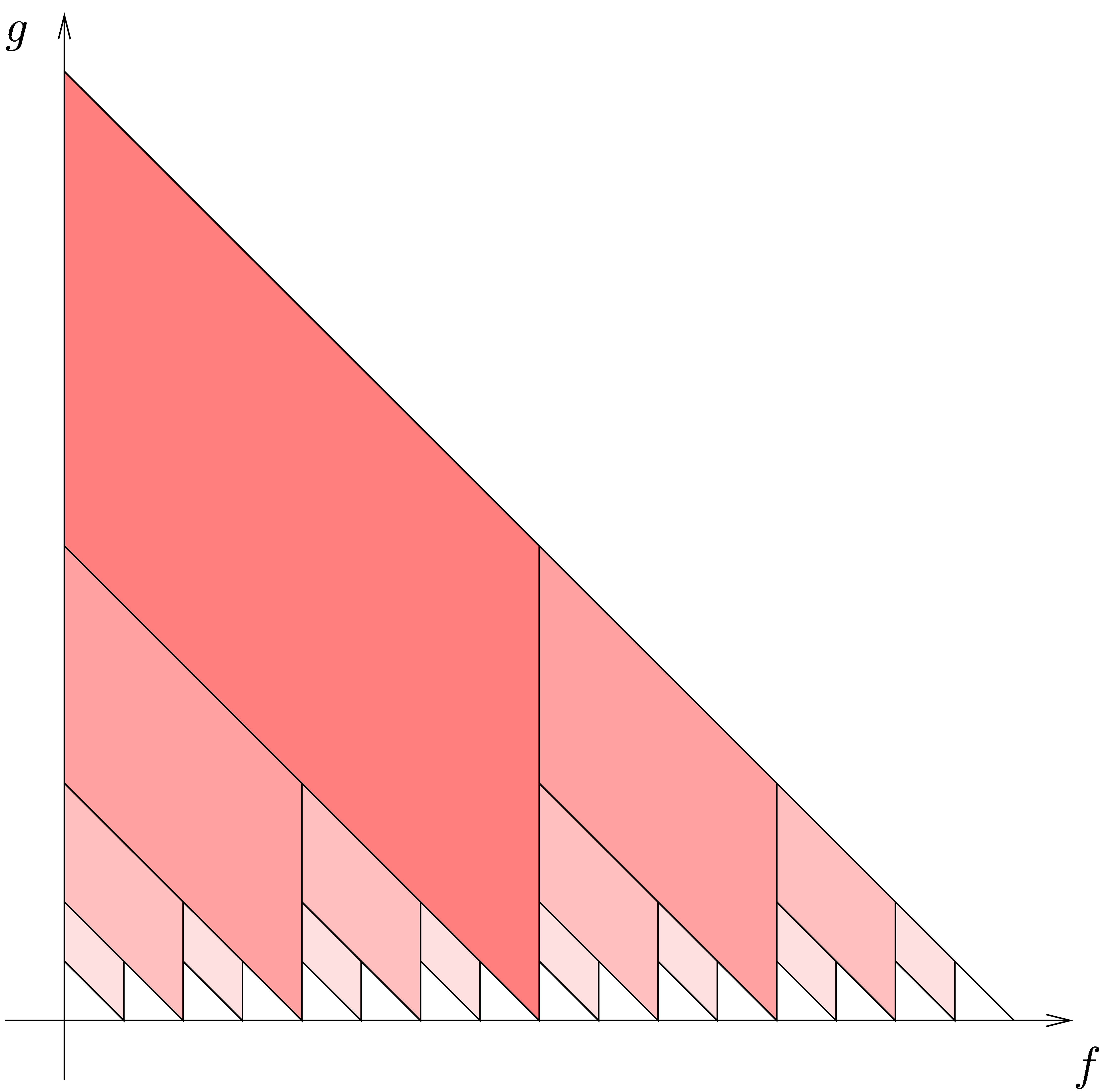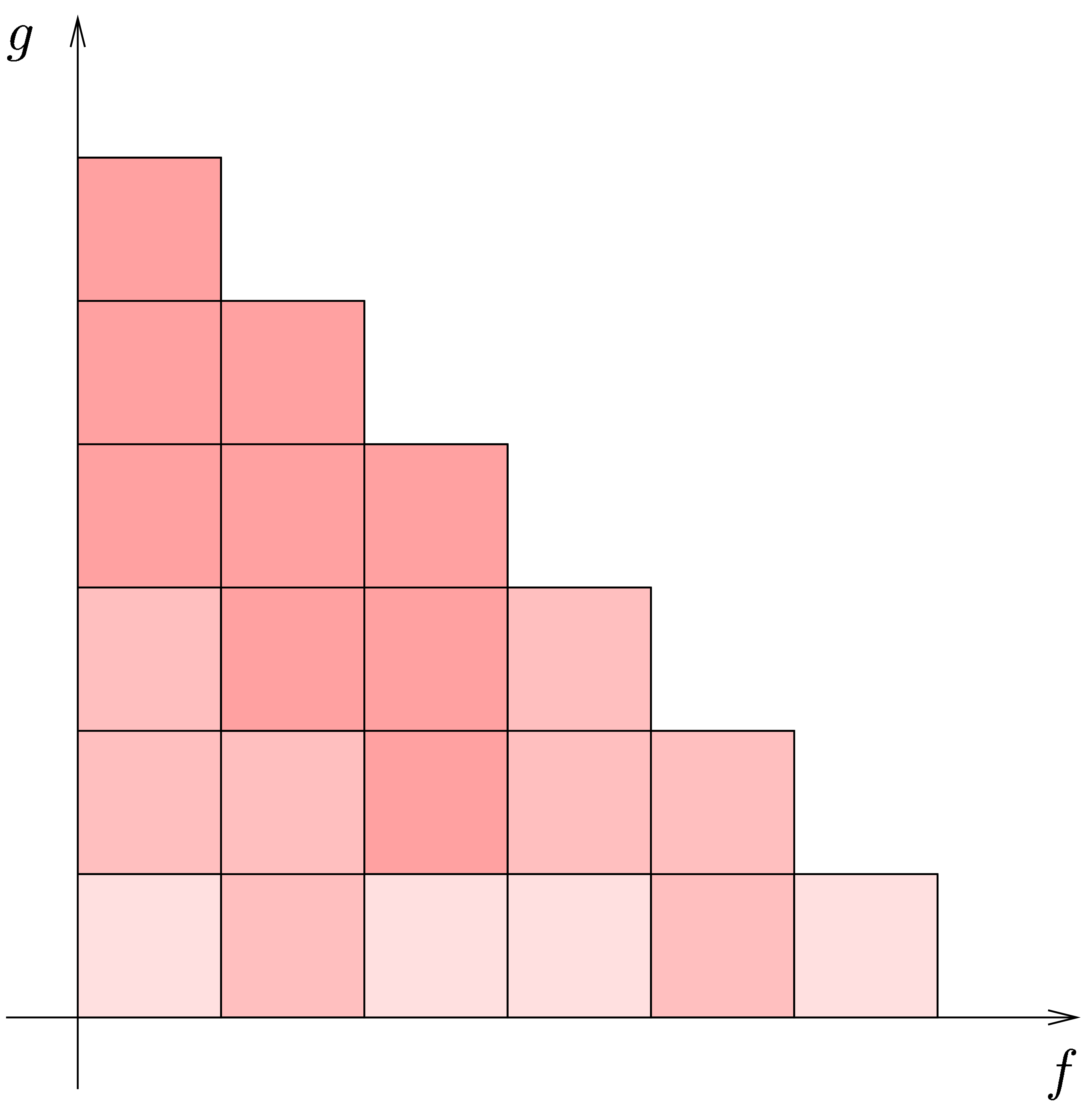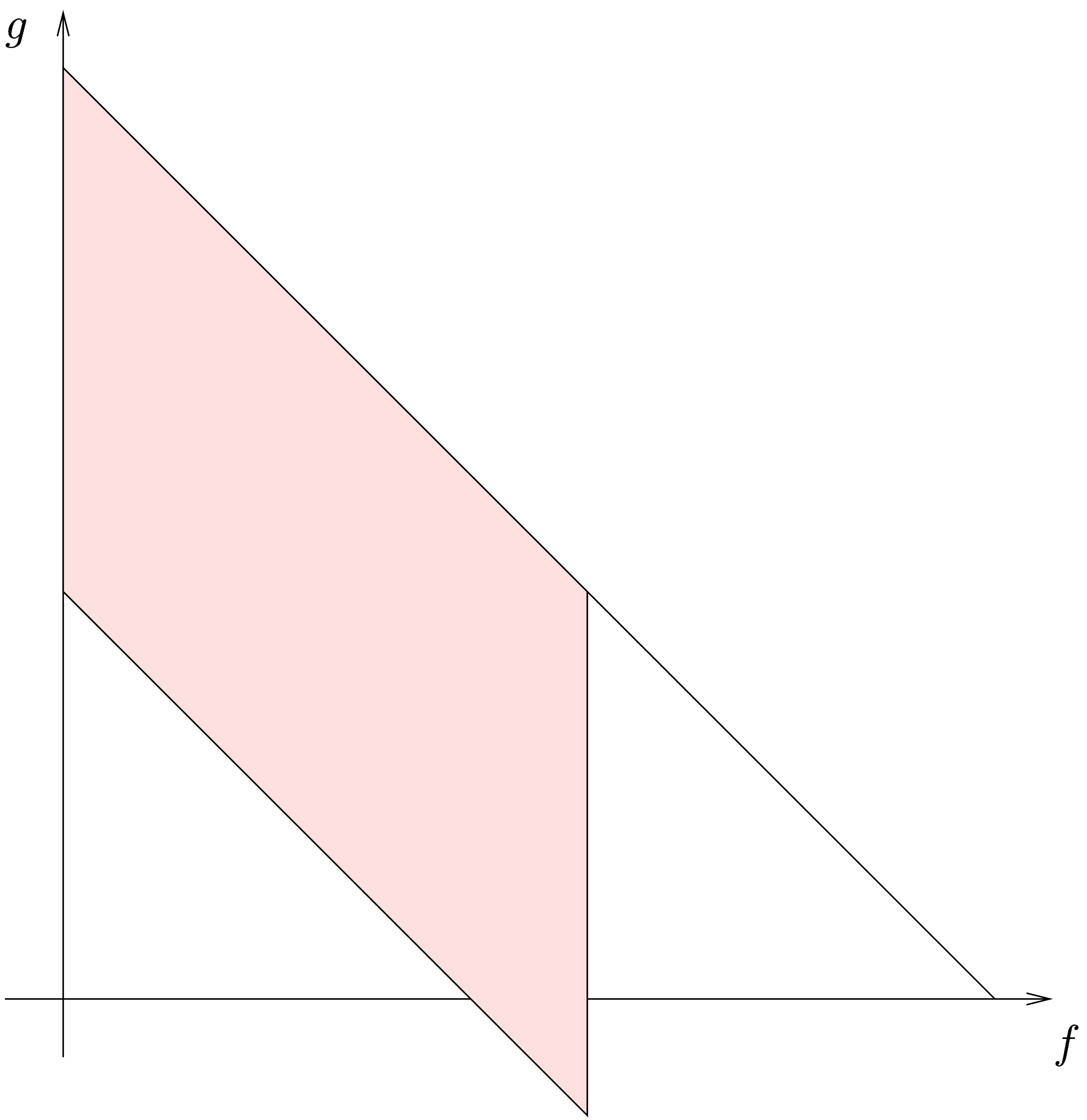 be an effective ring and consider two power
series
be an effective ring and consider two power
series  and
and  in
in  . In this paper we will be
concerned with the efficient computation of the first
. In this paper we will be
concerned with the efficient computation of the first  coefficients of the product
coefficients of the product  .
.
Dépt. de Mathématiques
(Bât. 425)
Université Paris-Sud
91405 Orsay Cedex
France
Email: joris@texmacs.org
Relaxed multiplication using the
middle product
August 3, 2003
Abstract
In previous work, we have introduced the technique of relaxed power series computations. With this technique, it is possible to solve implicit equations almost as quickly as doing the operations which occur in the implicit equation. In this paper, we present a new relaxed multiplication algorithm for the resolution of linear equations. The algorithm has the same asymptotic time complexity as our previous algorithms, but we improve the space overhead in the divide and conquer model and the constant factor in the F.F.T. model.
Let  be an effective ring and consider two power
series
be an effective ring and consider two power
series  and
and  in
in  . In this paper we will be
concerned with the efficient computation of the first
. In this paper we will be
concerned with the efficient computation of the first  coefficients of the product
coefficients of the product  .
.
If the first  coefficients of
coefficients of  and
and  are known beforehand, then we may use any
fast multiplication for polynomials in order to achieve this goal, such
as divide and conquer multiplication [KO63, Knu97],
which has a time complexity
are known beforehand, then we may use any
fast multiplication for polynomials in order to achieve this goal, such
as divide and conquer multiplication [KO63, Knu97],
which has a time complexity  ,
or F.F.T. multiplication [CT65, SS71,
CK91, vdH02], which has a time complexity
,
or F.F.T. multiplication [CT65, SS71,
CK91, vdH02], which has a time complexity
 .
.
For simplicity, “time complexity” stands for the required
number of operations in  .
Similarly, “space complexity” will stand for the number of
elements of
.
Similarly, “space complexity” will stand for the number of
elements of  which need to be stored. The
required number of multiplications
which need to be stored. The
required number of multiplications  in the divide
and conquer algorithm satisfies the following recurrence relations:
in the divide
and conquer algorithm satisfies the following recurrence relations:

When performing computing only the product truncated at order  , then the number of
multiplications
, then the number of
multiplications  needed by the divide and conquer
algorithm becomes
needed by the divide and conquer
algorithm becomes

For certain computations, and most importantly the resolution of
implicit equations, it is interesting to have so called “relaxed
algorithms” which output the first  coefficients of
coefficients of  as soon as the first
as soon as the first  coefficients of
coefficients of  and
and  are known for each
are known for each  .
This allows for instance the computation of the exponential
.
This allows for instance the computation of the exponential  of a series
of a series  with
with  using the formula
using the formula
 |
(1) |
In [vdH97, vdH02], we proved the following two theorems:
Theorem  and space complexity
and space complexity  ,
and which uses
,
and which uses  multiplications.
multiplications.
Theorem  and space complexity
and space complexity  .
.
Although these theorems are satisfactory from a theoretical point of view, they can be improved in two directions: by removing the logarithmic space overhead in the divide and conquer model and by improving the constant factor in the F.F.T. model.
In this paper, we will present such an improved algorithm in the case of
relaxed multiplication with a fixed series. More precisely, let  and
and  be power series, such
that
be power series, such
that  is known up to order
is known up to order  . Then our algorithm will compute the product
. Then our algorithm will compute the product  up to order
up to order  and output
and output  as soon as
as soon as  are known, for all
are known, for all
 . We will prove the
following:
. We will prove the
following:
Theorem  , of space
complexity
, of space
complexity  , and which uses
, and which uses
 multiplications.
multiplications.
We also obtain a better constant factor in the asymptotic complexity in the F.F.T. model, but this result is harder to state in a precise theorem.
The algorithm is useful for the relaxed resolution of linear
differential or difference equations. For instance, the exponential of a
series can be computed using  multiplications in
multiplications in
 . Moreover, the new algorithm
is very simple to implement, so it is likely to require less overhead
than the algorithm from theorem 1.
. Moreover, the new algorithm
is very simple to implement, so it is likely to require less overhead
than the algorithm from theorem 1.
Our algorithm is based on the recent middle product algorithm [HQZ00, HQZ02], which is recalled in section 2. In section 3 we present our new algorithm and in section 5 we give some applications.
In our algorithms we will use the following notations: the data type
 stands for truncated power series of order
stands for truncated power series of order  , like
, like  . Given
. Given  and
and  , we will denote
, we will denote  .
Given
.
Given  and
and  ,
we also denote
,
we also denote  . We will
denote by
. We will
denote by  the type, whose elements are
references to elements of type
the type, whose elements are
references to elements of type  .
If
.
If  and
and  ,
then we assume that
,
then we assume that  .
.
Let  and
and  be two truncated
power series at orders
be two truncated
power series at orders  resp.
resp.  . The middle product
. The middle product  and
and  is defined to be the
truncated power series
is defined to be the
truncated power series  of order
of order  , such that
, such that  for all
for all
 . In figure 1,
. In figure 1,
 corresponds to the colored region.
corresponds to the colored region.

The middle product of  and
and  can be computed using only three multiplications, using the following
trick:
can be computed using only three multiplications, using the following
trick:

This trick may be applied recursively in order to yield an algorithm
which needs exactly the same number of multiplications  as the divide and conquer algorithm for the computation of the product
of two polynomials of degree
as the divide and conquer algorithm for the computation of the product
of two polynomials of degree  .
More precisely, the following recursive algorithm comes from [HQZ00,
HQZ02].
.
More precisely, the following recursive algorithm comes from [HQZ00,
HQZ02].
Algorithm 
Input  and
and 
Output their middle product 
 then
return
then
return 


 is even
is even
then 
else 


In [HQZ02] it is also shown that, in the F.F.T. model, the middle product can still be computed in essentially the same time as the product of two polynomials.
Let  and
and  be power series,
such that
be power series,
such that  is known up to order
is known up to order  . In this section, we present an algorithm
which computes the product
. In this section, we present an algorithm
which computes the product  up to order
up to order  . For each
. For each  , the algorithm outputs
, the algorithm outputs  as
soon as
as
soon as  are known.
are known.
The idea of our algorithm is similar to the idea behind fast relaxed multiplication in [vdH97, vdH02] and based on a subdivision of the triangular area which corresponds to the computation of the truncated power series product. This subdivision is shown in figures 2 and 3, where each parallelogram corresponds to the computation of a middle product.

More precisely, let  and assume that
and assume that  are known. Then the contribution of
are known. Then the contribution of  to
to  may be computed using the middle product
algorithm from the previous section. The relaxed truncated products
may be computed using the middle product
algorithm from the previous section. The relaxed truncated products  and
and  may be computed
recursively.
may be computed
recursively.
In order to implement this idea, we will use an in-place algorithm,
which adds the result of  to a reference
to a reference  to an element of
to an element of  .
Denote by
.
Denote by  the initial value of
the initial value of  . Then the in-place algorithm should be called
successively for
. Then the in-place algorithm should be called
successively for  . After the
last call, we have
. After the
last call, we have  . Taking
. Taking
 , the algorithm computes
, the algorithm computes
 .
.
Algorithm 
Input  ,
,
 ,
,  .
.
Action we have  on exit.
on exit.
 then
then  and return
and return

 then
then 
 then
then 
 then
then 
The number of multiplications  used by
used by  is determined by the relations
is determined by the relations

By induction, it follows that  .
The overall time complexity satisfies
.
The overall time complexity satisfies

so  . The algorithm being
in-place, its space complexity is clearly
. The algorithm being
in-place, its space complexity is clearly  .
This proves theorem 3.
.
This proves theorem 3.
In it is also interesting to use the above algorithm in the F.F.T. model. We then have the estimation

for the asymptotic complexity  .
If
.
If  , this yields
, this yields

This should be compared with the complexity  of
the previously best algorithm and with the complexity
of
the previously best algorithm and with the complexity  of the standard fast relaxed multiplication algorithm.
of the standard fast relaxed multiplication algorithm.
Notice that we rarely obtain the complexity  in
practice. In the range where
in
practice. In the range where  ,
we obtain
,
we obtain

Let us consider the computation of  up till order
up till order
 using our algorithm and the formula
using our algorithm and the formula

with  and
and  .
We start with
.
We start with  in
in  and
perform the following computations at successive calls for
and
perform the following computations at successive calls for  :
:
We set  , so that
, so that

and  .
.
We recursively apply  to
to  ,
,  ,
,
 and
and  .
This requires the computation of
.
This requires the computation of  .
We thus increase
.
We thus increase  , so
that
, so
that

and  .
.
The two nested recursive calls to  now lead
to the increase of
now lead
to the increase of  by
by  , so that
, so that

and  .
.
We now both have  and
and  . So we first compute
. So we first compute  and set
and set  . We next
recursively apply
. We next
recursively apply  to
to  ,
,  ,
,
 and
and  ,
which leads to an increase of
,
which leads to an increase of  by
by  . Alltogether, we obtain
. Alltogether, we obtain

and  .
.
We recursively apply  to
to  ,
,  ,
,
 and
and  .
This leads to the increase
.
This leads to the increase  ,
so that
,
so that

and  .
.
The two nested recursive calls lead to the increase  , so that
, so that

and  .
.
The entire computation is represented schematically in figure 3.

First of all, let us consider the problem of relaxed division by a fixed
power series. In other words, we are given two power series  and
and  , where
, where
 is known up to order
is known up to order  and
and
 . We want an algorithm for
the computation of
. We want an algorithm for
the computation of  up to order
up to order  , such that
, such that  is computed
as soon as
is computed
as soon as  are known for each
are known for each  . Now we have
. Now we have

where  . We may thus compute
. We may thus compute
 in a relaxed way using the algorithm from the
previous section. Computing
in a relaxed way using the algorithm from the
previous section. Computing  up till
up till  terms will then necessitate
terms will then necessitate  multiplications in
multiplications in  .
.
Let us next consider a linear differential equation
 |
(2) |
with  and
and  .
Given initial conditions for
.
Given initial conditions for  ,
there exists a unique solution to this equation. We may compute this
solution using the relaxed algorithm from the previous section, the
above algorithm for relaxed division, and the formula
,
there exists a unique solution to this equation. We may compute this
solution using the relaxed algorithm from the previous section, the
above algorithm for relaxed division, and the formula

In order to compute  coefficients, we need to
perform
coefficients, we need to
perform  multiplications in
multiplications in  and
and  multiplications and divisions by integers.
If
multiplications and divisions by integers.
If  , then we only need
, then we only need  multiplications.
multiplications.
For instance, the exponential  of a series
of a series  with
with  satisfies the equation
satisfies the equation

so  can be computed using
can be computed using  multiplications, using the formula (1).
multiplications, using the formula (1).
More generally, consider the solution to (2) with the
prescribed initial conditions, and let  be
another series with
be
another series with  . Then
the composition
. Then
the composition  again satisfies a linear
differential equation. Indeed, we have the relations
again satisfies a linear
differential equation. Indeed, we have the relations

Postcomposing (2) with  and using
these relations, we obtain a linear differential equation for
and using
these relations, we obtain a linear differential equation for  .
.
In fact, our algorithm may be used to solve far more general linear equations, such as linear partial differential equations, or linear differential-difference equations. In the case of difference equations, we notice that the relaxed multiplications in the algorithms from [vdH02] for relaxed right composition with a fixed series all have one fixed argument. So we may indeed apply the algorithm from section 3.
We finally notice that our algorithm can even be used in a non-linear
context. Indeed, after computing  coefficients of
a truncated relaxed product, the computation of the remaining products
reduces to the computation of two truncated relaxed products with one
fixed argument. Actually, this corresponds to an implicit application of
Newton's method.
coefficients of
a truncated relaxed product, the computation of the remaining products
reduces to the computation of two truncated relaxed products with one
fixed argument. Actually, this corresponds to an implicit application of
Newton's method.
We have presented a new algorithm for relaxed multiplication. Although the new algorithm does not yield a significant improvement from the asymptotic complexity point of view, we do expect it to be very useful for practical applications, such as the exponentiation of power series.
First of all, the algorithm is easy to implement. Secondly, it only needs a linear amount of memory in the range where divide and conquer multiplication is appropriate. In combination with F.F.T. multiplication, the algorithm yields a better constant factor in the asymptotic complexity.
When implementing a library for power series computations, it is interesting to incorporate a mechanism to automatically detect relaxed and fixed multiplicands in a complex computation. This is possible by examining the dependency graph. With such a mechanism, one may use the new algorithm whenever possible.
Some interesting questions remain open in the divide and conquer model:
can we apply Mulders' trick [Mul00, HZ02] for
the computation of “short products” in our setting while
maintaining the linear space complexity (see figure 4)? In
that case, we might improve the number of multiplications in theorem 3 to  .
.

In a similar vein, does there exist a relaxed multiplication algorithm
of time complexity  and linear space complexity?
This would be so, if the middle product algorithm could be made relaxed
in an in-place way (the algorithm is already “essentially
relaxed” in the sense of [vdH97, vdH02]
in the divide and conquer model).
and linear space complexity?
This would be so, if the middle product algorithm could be made relaxed
in an in-place way (the algorithm is already “essentially
relaxed” in the sense of [vdH97, vdH02]
in the divide and conquer model).
As it stands now, with the above questions still unanswered, the
original relaxed multiplication algorithm from theorem 1
remains best from the time complexity point of view in the divide and
conquer model. Moreover, Mulders' trick can be applied in this setting,
so as to yield a short relaxed multiplication algorithm of complexity
 , or even better [HZ02].
, or even better [HZ02].
This has surprising consequences for the complexities of several
operations like short division and square roots: we obtain algorithms of
time complexities  and
and  when using
when using  space, while the best known
algorithms which use linear space have time complexities
space, while the best known
algorithms which use linear space have time complexities  and
and  . In order
to obtain the complexity of
. In order
to obtain the complexity of  in the case of
square roots, one should use a relaxed version of the fast squaring
algorithm from [HQZ02], which is based on middle products.
in the case of
square roots, one should use a relaxed version of the fast squaring
algorithm from [HQZ02], which is based on middle products.
We finally remark that this relaxed version of squaring using middle
products is also interesting in the F.F.T. model. In this
case, the relaxed middle product corresponds to a full relaxed product
with one fixed argument. Such products can be computed in time  , so that we obtain a relaxed
squaring algorithm of time complexity
, so that we obtain a relaxed
squaring algorithm of time complexity  .
This is twice as good as general relaxed multiplication. In the
non-relaxed setting, squares can be computed in a time between
.
This is twice as good as general relaxed multiplication. In the
non-relaxed setting, squares can be computed in a time between  and
and  , depending
on whether most time is spent on inner multiplications or fast Fourier
transforms respectively.
, depending
on whether most time is spent on inner multiplications or fast Fourier
transforms respectively.
D.G. Cantor and E. Kaltofen. On fast multiplication of polynomials over arbitrary algebras. Acta Informatica, 28:693–701, 1991.
J.W. Cooley and J.W. Tukey. An algorithm for the machine calculation of complex Fourier series. Math. Computat., 19:297–301, 1965.
Guillaume Hanrot, Michel Quercia, and Paul Zimmermann. Speeding up the division and square root of power series. Research Report 3973, INRIA, July 2000. Available from http://www.inria.fr/RRRT/RR-3973.html.
Guillaume Hanrot, Michel Quercia, and Paul Zimmermann. The middle product algorithm I. speeding up the division and square root of power series. Accepted for publication in AAECC, 2002.
Guillaume Hanrot and Paul Zimmermann. A long note on Mulders' short product. Research Report 4654, INRIA, December 2002. Available from http://www.loria.fr/ hanrot/Papers/mulders.ps.
D.E. Knuth. The Art of Computer Programming, volume 2: Seminumerical Algorithms. Addison-Wesley, 3-rd edition, 1997.
A. Karatsuba and J. Ofman. Multiplication of multidigit numbers on automata. Soviet Physics Doklady, 7:595–596, 1963.
T. Mulders. On short multiplication and division. AAECC, 11(1):69–88, 2000.
A. Schönhage and V. Strassen. Schnelle Multiplikation grosser Zahlen. Computing 7, 7:281–292, 1971.
J. van der Hoeven. Lazy multiplication of formal power series. In W. W. Küchlin, editor, Proc. ISSAC '97, pages 17–20, Maui, Hawaii, July 1997.
J. van der Hoeven. Relax, but don't be too lazy. JSC, 34:479–542, 2002.